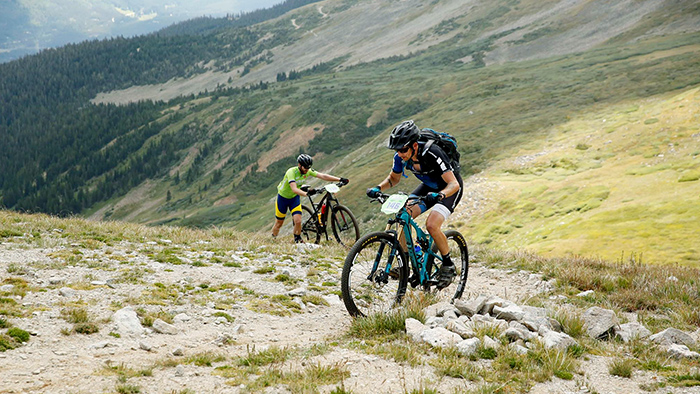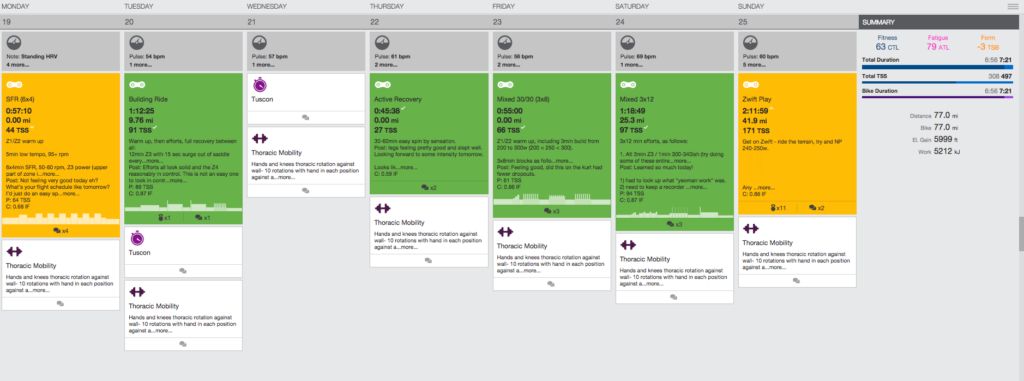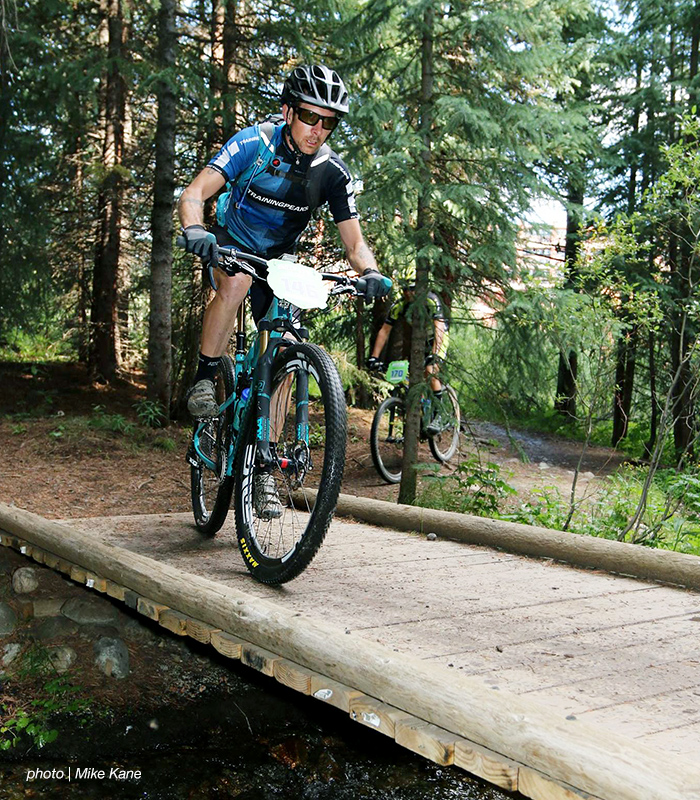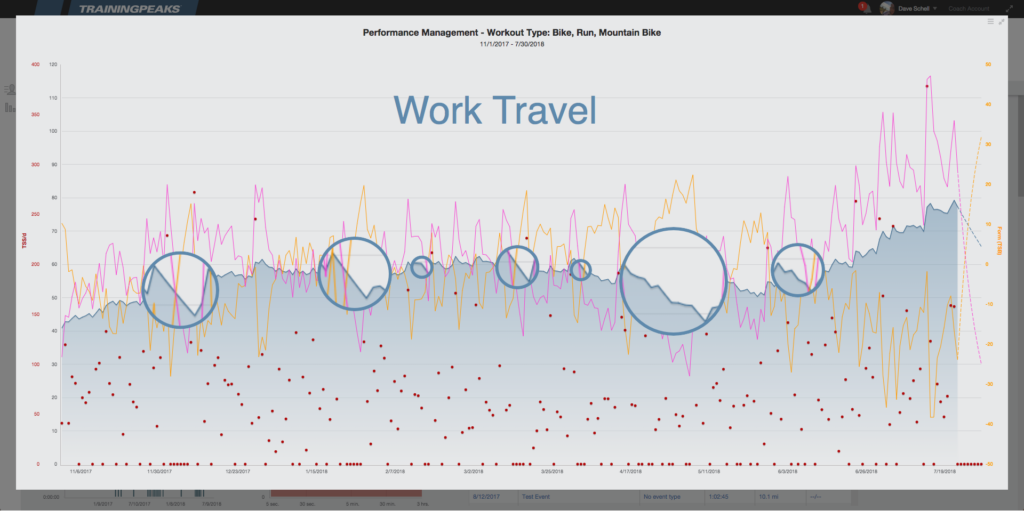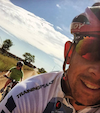As part of my role as Education manager here at TrainingPeaks, I travel all over the world teaching athletes and coaches how to get the most out of their TrainingPeaks accounts. As you can imagine, this hectic work travel schedule is not conducive to training, especially when your ‘A’ race is the Breck Epic, a 6-day mountain bike stage race with 40,000 feet of climbing!
I have typically planned my own workouts each season, but this year I decided work with a coach: Nate Wilson of Catalyst Coaching. I wanted to be pushed outside my comfort zone, get an objective opinion, and take workout planning off my to-do list. Here are few key elements Nate and I focused on to get the most effective training on my limited schedule.
Make Friends with the Trainer
During the cold, dark days of the winter, we went for quality over quantity by leveraging the power of the trainer. I did 2-3 quality sessions during the week, with intervals aimed at raising my FTP. On weekends when I had more time, I did one or two more endurance sessions.
For the quality sessions, we used the TrainingPeaks workout builder to eliminate any room for confusion or uncertainty. By transferring the workouts to my Garmin, I knew exactly how long my work and recovery intervals were, and my precise power targets.
For the longer rides we broke up the monotony by using a smart trainer and dropping into a virtual group ride, which made the time fly by. These trainer sessions were much more fun than aimlessly slogging along at a constant wattage!
Nate’s take:
When light is limited and temperatures are low, there is not a lot of point in trying to emulate a classical periodization model where January and February might mean long aerobic base miles. For someone with six hours available to ride each week, they just end up with pretty slow progress.
Rather than getting hung up on specifics, I focused on trying to build Dave’s general fitness as much as possible—which meant more intensity to get more bang for our buck. This also helped keep workouts varied and fun, so that even though intensity was high, he arrived to the summer mentally fresh and ready to keep working hard.
Long rides don’t have to be “just riding” for the sake of it. There is nothing wrong with dropping some intervals in, or a virtual group ride to break the time up. A lot of speed can be gained by improved technique, whether it be pedal stroke efficiency, the ability to comfortably ride out of the saddle, or riding at varied cadences. A 2.5-3 hour “base” ride on the trainer is the perfect time to incorporate some technique work which, when riding outside, might get forgotten.
Get Comfortable on Unfamiliar Trails
Once it started to warm up we still utilized the turbo trainer quite a bit for the efficiency (not having to find an optimal stretch of road to start my intervals saved a ton of time. I could wake up early, knock out a quality workout, and be in the office having started my day off on a positive note. Then, on the weekends we took it to the trails for some specificity. As great as the trainer is, there is just no replicating the beating your body takes from a rocky trail!
Nate’s Take:
Having done so much quality work on the trainer before summer hit, we didn’t have to worry about combining technical skill work with structured workouts once the trails dried out. We were confident that we’d brought Dave’s fitness to a good place, and that the most important thing to do next was to build up the technical specificity that Breck Epic requires.
In a lot of ways we were getting more task-specific as we approached our target event—but that didn’t occur via super-specific workouts. It came much more in just spending time on trail, and on as many different trails as possible. I see mountain bike athletes all the time who have their “home trail, and they just get really good at riding that. While having a trail system you know well and can ride fast is a great resource, It’s also important to be able to show up at a race and know how to “read the trail”. Since it was unrealistic for Dave to get comfortable on the 250 combined miles of the Breck Epic, the next best thing was to spend a lot of time on unknown trail and get him comfortable with the unfamiliar.
Manage Fitness and Fatigue
I travel for work fairly often, which can make riding really tough. I’ve never been a fan of hotel gym bikes, and even if I’d brought my own bike to ride outside, it can be really stressful to find new routes and anticipate international driving laws. So on travel stretches (of 1-2 weeks at a time) I just busted out the running shoes. It was nice to take a break from a bike and there really is no better way to explore a city than on foot. In addition, running can help to address some of the deficiencies and imbalances that tend to develop over time if all you do is ride.
Due to the frequency of my work travel, and the unpredictability of changing seasons, it was difficult to string together a lot of uninterrupted training time. So, we worked with what we had available and planned to overreach a bit when we knew a trip was on the horizon. With this strategy we would go into a “hole,” knowing that while I was away I would have a lot of time to recover. Mind you however, sitting on a plane for 18 hours is not ideal recovery.
Nate’s Take:
Rather than stressing about missed time on the bike, or trying to mimic workouts on a hotel bike (and perhaps coming home with tendonitis from going all-out on a bike that doesn’t fit), we were able to get some recovery and mental freshness during the travel periods. Running was great training, but also allowed Dave to come home and have really focused periods on the bike. He may have taken some more time off the bike than folks without a travel schedule, but it also allowed him to work harder and stay more focused during his “on the bike” periods.
Add Specificity with Fun Races
Luckily the last two months before my a race did not contain any travel and allowed us to really buckle down and put the finishing touches on my preparation. With the nicer weather and more time available time we upped the volume a bit by adding commutes to and from work when the weather allowed. I also logged some substantial trail time, and added some specificity with a few lower-priority fun races.
When the Breck Epic rolled around, it went well. I felt prepared and like I was riding stronger than last year. A shortened first stage due to weather meant I had the energy to really push it on the later stages, and I managed a 3rd place on stage 5, which moved me up into top 10 in the GC. I had some early setbacks due to mechanicals, but that turned out to be a blessing in disguise, as it provided some unplanned recovery and forced me to pace the earlier stages more conservatively.
Time comes at a premium for most busy adults balancing a life, family, and training. But by enlisting the help of a qualified expert you can make the most of your limited training time and still enjoy the rush of accomplishing your goal!
